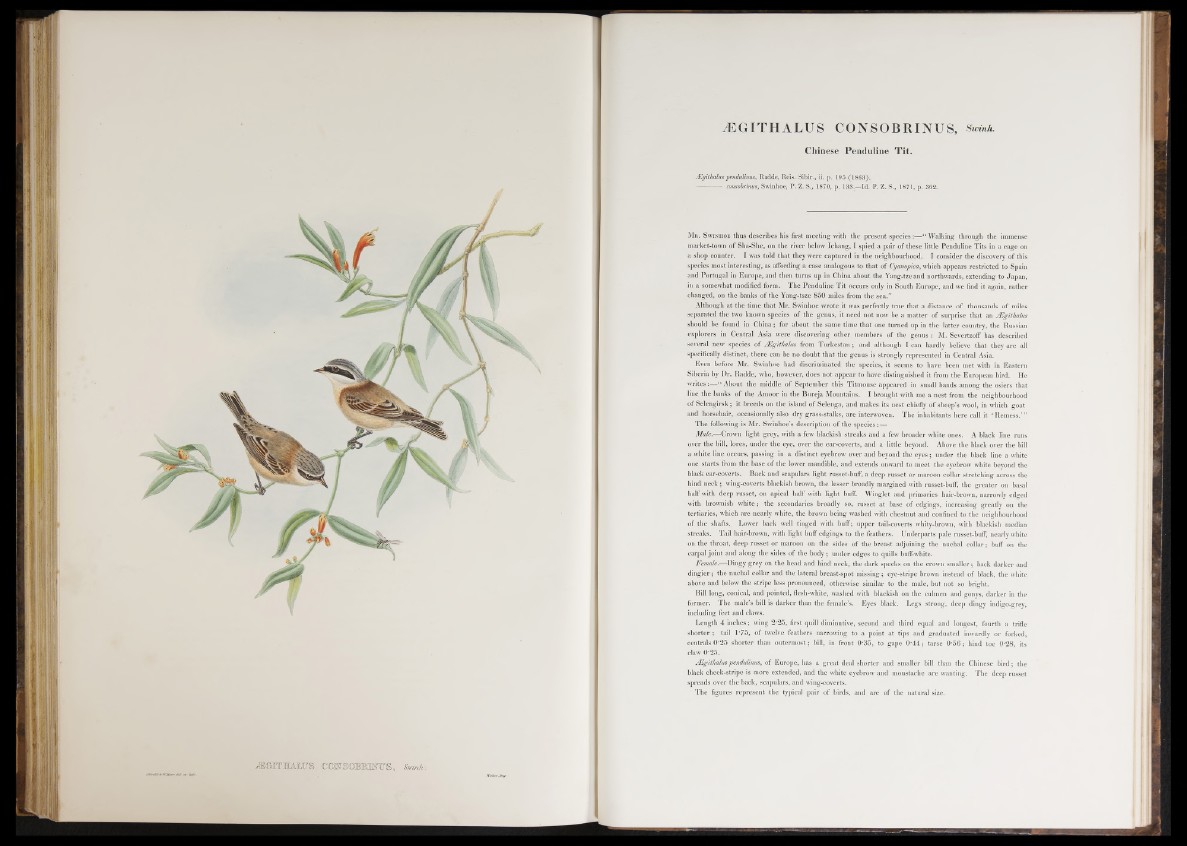
/EGITHAIIJS CQN’SQBmmT S, Smnh-.
^ E G I T H A L U S C O N S O B R I N U S , Swinh.
Chinese Penduliue Tit.
ASgithalus pendulinus, Radde, Reis. Sibir., ii. p. 195 (1863).
’— consobrinus, Swinhoe, P. Z. S., 1870, p, 133.—Id. P. Z. S., 1871, p. 362.
M r . S w in h o e thus describes his first meeting with the present species:— “ Walking through the immense
market-town of Sha-She, on the river below Ichang, I spied a pair of these little Penduline Tits in a cage on
a shop counter. I was told that they were captured in the neighbourhood. I consider the discovery of this
species most interesting, as affording a case analogous to that of Cyanopica, which appears restricted to Spain
and Portugal in Europe, and then turns up in China about the Yang-tze and northwards, extending to Japan,
in a somewhat modified form. The Penduline T it occurs only in South Europe, and we find it again, rather
changed, on the banks of the Yang-tsze 850 miles from the sea.”
Although at the time that Mr. Swinhoe wrote it was perfectly true that a distance of thousands o f miles
separated the two known species o f the genus, it need not now be a matter o f surprise that an ¿Egithalus
should be found in China; for about the same time that one turned up in the latter country, the Russian
explorers in Central Asia were discovering other members o f the genus : M. Severtzoff has described
several new species of ¿Egithalus from T urkestan; and although I can hardly believe that they are all
specifically distinct, there can be no doubt that the genus is strongly represented in Central Asia.
Even before Mr. Swinhoe had discriminated the species, it seems to have been met with in Eastern
Siberia by Dr. Radde, who, however, does not appear to have distinguished it from the European bird. He
w r i t e s “ About the middle of September this Titmouse appeared in small bands among the osiers that
line the banks o f the Amoor in the Bureja Mountains. I brought with me a nest from the neighbourhood
of Selengirsk; it breeds on the island of Selenga, and makes its nest chiefly of sheep’s wool, in which goat
and horsehair, occasionally also dry grass-stalks, are interwoven. The inhabitants here call it ‘ Remess.’ ”
The following is Mr. Swinhoe's description o f the s p e c ie s ^ ^ ^H
Male.— Crown light grey, with a few blackish streaks and a few broader white ones. A black line runs
over the bill, lores, under the eye, over the ear-coverts, and a little beyond. Above the black over the bill
a white line occurs, passing in a distinct eyebrow over and beyond the eyes; under the black line a white
one starts from the base of the lower mandible, and extends onward to meet the eyebrow white beyond the
black ear-coverts. Back and scapulars light russet-buff, a deep russet or maroon collar stretching across the
hind n eck; wing-coverts blackish brown, the lesser broadly margined with russet-buff, the greater on basal
half with deep russet, on apical half with light buff. Winglet and primaries hair-brown, narrowly edged
with brownish white; the secondaries broadly so, russet a t base of edgings, increasing greatly on the
tertiaries, which are nearly white, the brown being washed with chestnut and confined to the neighbourhood
of the shafts. Lower back well tinged with buff; upper tail-coverts whity-brown, with blackish median
streaks. Tail hair-brown, with light buff edgings to the feathers. Underparts pale russet-buff, nearly white
on the throat, deep russet or maroon on the sides o f the breast adjoining the nuchal collar; buff on the
carpal joint and along the sides o f the body; under edges to quills buff-white.
Female.—Dingy grey on the head and hind neck, the dark specks on the crown smaller; back darker and
dingier; the nuchal collar and the lateral breast-spot missing; eye-stripe brown instead of black, the white
above and below the stripe less pronounced, otherwise similar to the male, but not so bright.
Bill long, conical, and pointed, flesh-white, washed with blackish on the culmen and gonys, darker in the
former. The male’s bill is darker than the female’s. Eyes black. Legs strong, deep dingy indigo-grey,
including feet and claws.
Length 4 inches; wing 2-25, first quill diminutive, second and third equal and longest, fourth a trifle
shorter ; tail 1'75, o f twelve feathers narrowing to a point at tips and graduated inwardly or forked,
centrals 0 25 shorter than outermost; bill, in front 0 35, to gape 0-44; tarse 0-56; hind toe 0’28, its
claw 0-25.
/Egitlialus pendulinus, of Europe, has a great deal shorter and smaller bill than the Chinese bird; the
black cheek-stripe is more extended, and the white eyebrow and moustache are wanting. The deep russet
spreads over the back, scapulars, and wing-coverts.
The figures represent the typical pair of birds, and are of the natural size.